HCL Technologies Bundle
Who Really Owns HCL Technologies?
Unraveling the ownership of HCL Technologies, a titan in the IT world, is key to understanding its strategic moves and future prospects. From its humble beginnings to its current status as a global force, the evolution of HCL company ownership tells a compelling story of growth and adaptation. This exploration is particularly timely, given the ongoing leadership transitions and shifts in shareholder dynamics.
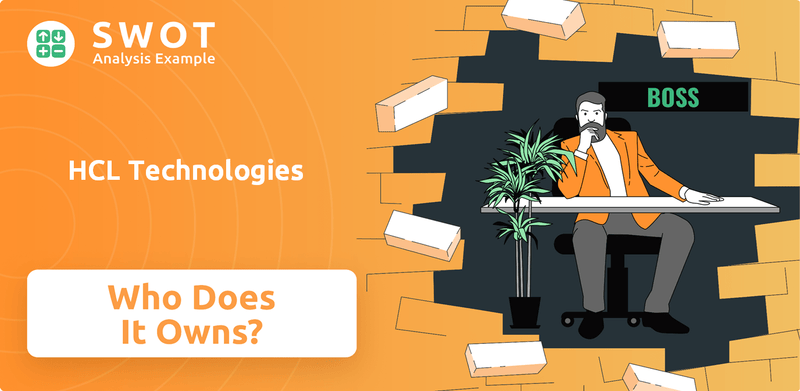
Understanding the HCL Technologies SWOT Analysis is crucial for investors and strategists alike. The company, now known as HCLTech, was founded by HCL founder Shiv Nadar, and its ownership structure has been significantly shaped by his succession planning. This article will provide a deep dive into the HCL Technologies ownership structure, including major stakeholders and the role of HCL leadership, to offer a comprehensive view of this influential IT firm. Examining who owns HCL is essential for anyone looking to understand its direction.
Who Founded HCL Technologies?
The story of HCL Technologies begins in 1976, rooted in the vision of Shiv Nadar and a team of seven other engineers. This collaborative spirit and initial focus on technology laid the groundwork for what would become a global IT powerhouse. The early ownership structure, though not fully detailed in public records, was primarily driven by Nadar's leadership.
Initially known as Microcomp Limited, the company quickly evolved, changing its name to Hindustan Computers Limited (HCL) on August 11, 1976. This marked a significant step in its journey, fueled by an initial capital of Rs. 187,000. The evolution from selling calculators to developing microcomputers and eventually software and services showcases the company's adaptability and foresight.
HCL Technologies, as a separate entity, emerged from HCL Enterprise's Research & Development division. It was formally established as HCL Overseas Limited on November 12, 1991, to concentrate on software and technology development. The company's name later changed to HCL Consulting Limited in 1994.
The early ownership of HCL Technologies was shaped by the founders' vision and the company's strategic shifts. While specific equity splits from the initial days are not widely available, Shiv Nadar's central role is undeniable. His leadership was crucial in steering the company from its inception. Arjun Malhotra, a co-founder, later left the company in 1998 to pursue his own ventures, reflecting the dynamic nature of early-stage ownership and the evolution of the company's leadership. For more insights, consider exploring the Growth Strategy of HCL Technologies.
- Shiv Nadar was the primary founder and driving force.
- The initial focus was on indigenous microcomputer development, later shifting to software and services.
- The company's structure evolved from HCL Enterprise to HCL Overseas Limited and then HCL Consulting Limited.
- Arjun Malhotra, a co-founder, departed in 1998.
HCL Technologies SWOT Analysis
- Complete SWOT Breakdown
- Fully Customizable
- Editable in Excel & Word
- Professional Formatting
- Investor-Ready Format
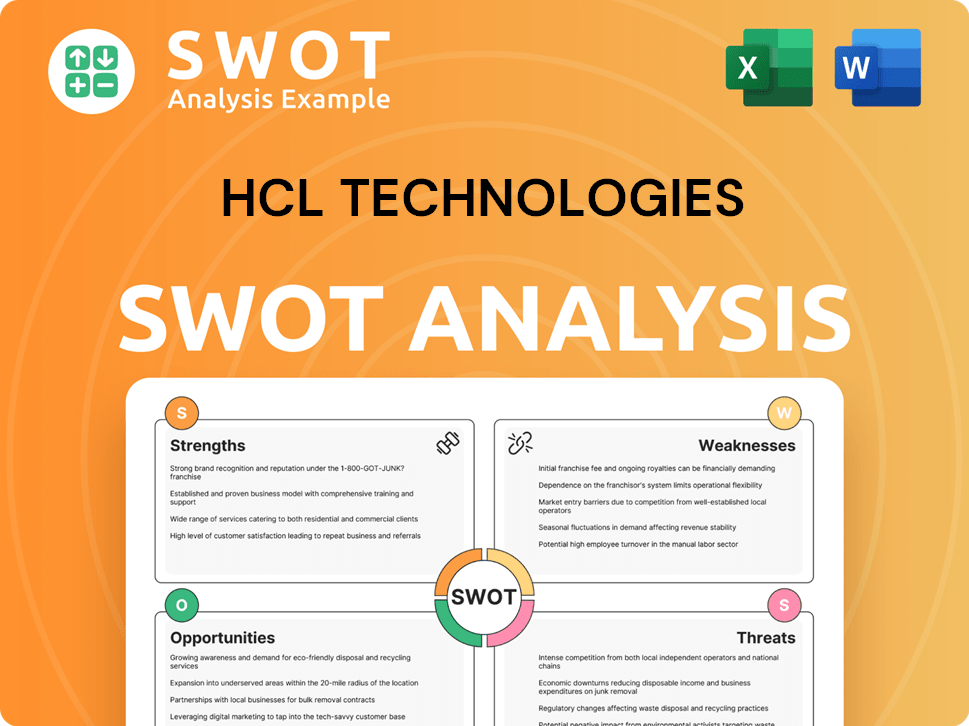
How Has HCL Technologies’s Ownership Changed Over Time?
The ownership structure of HCL Technologies has evolved significantly since its initial public offering on January 11, 2000. The company's journey from a private entity to a publicly traded corporation has seen shifts in shareholder composition, with key individuals and institutional investors playing pivotal roles. Understanding the ownership dynamics provides insights into the company's strategic direction and stability.
A notable event influencing the ownership was the strategic transfer of shares by Shiv Nadar, the HCL founder, to his daughter, Roshni Nadar Malhotra. This transfer, executed on March 6, 2025, via gift deeds, streamlined the succession plan and solidified her position as the largest shareholder, ensuring continuity in family ownership and control. This move reflects a deliberate approach to succession planning, aiming to provide stability to the company.
| Shareholder Category | As of June 6, 2024 | As of March 31, 2025 |
|---|---|---|
| Promoter Holding | 60.81% | 60.81% |
| Foreign Institutional Investors (FIIs) | 18.45% | 19.15% |
| Domestic Institutional Investors (DIIs) | 15.73% | 15.39% |
As of March 31, 2025, the promoter holding in HCLTech remains stable at 60.81%. The majority of this is held by Shiv Nadar through promoter entities, with Vama Sundari Investments (Delhi) Private Limited holding 44.17% as of June 6, 2025. Foreign Institutional Investors (FIIs) held 19.15% of the company as of March 31, 2025, and Domestic Institutional Investors (DIIs) held 15.39%. Mutual Funds increased their holdings from 8.19% to 8.35% in the March 2025 quarter. The Life Insurance Corporation of India holds 4.83%, and individual investors account for 3.37%.
The ownership of HCL Technologies is primarily controlled by the promoters, with Shiv Nadar and his family holding a significant stake.
- The founder, Shiv Nadar, transferred a significant portion of his shares to his daughter, Roshni Nadar Malhotra, ensuring family control.
- Institutional investors, including FIIs and DIIs, hold a substantial portion of the company's shares.
- The ownership structure reflects a blend of promoter control and institutional investment, contributing to the company's stability and strategic direction.
- To know more about the company's performance, check out this article about HCL Technologies.
HCL Technologies PESTLE Analysis
- Covers All 6 PESTLE Categories
- No Research Needed – Save Hours of Work
- Built by Experts, Trusted by Consultants
- Instant Download, Ready to Use
- 100% Editable, Fully Customizable
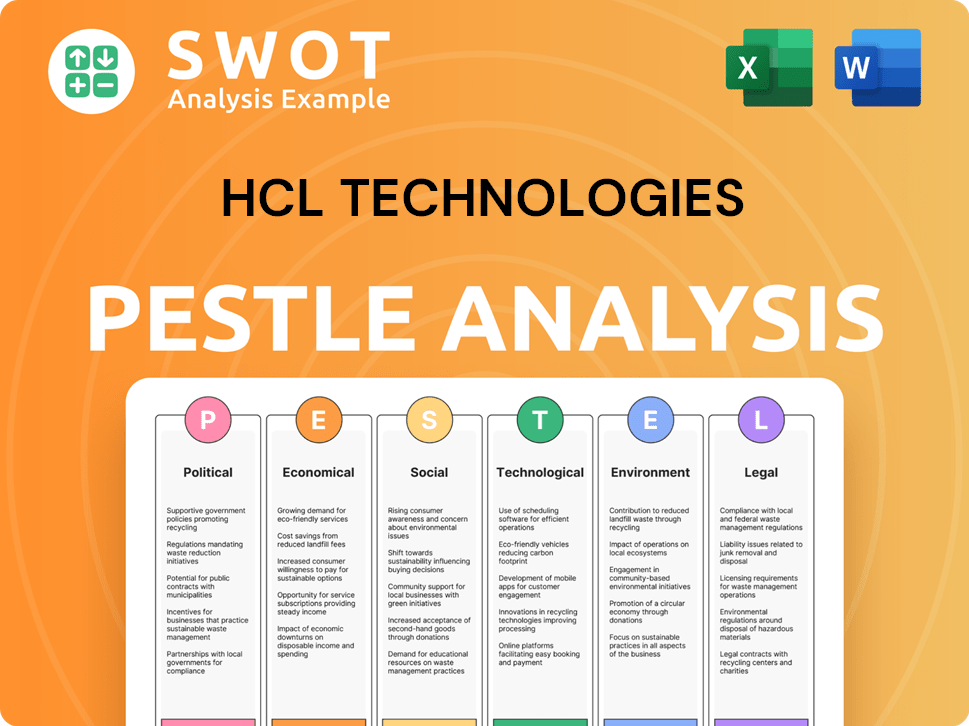
Who Sits on HCL Technologies’s Board?
The Board of Directors of HCL Technologies plays a key role in governing the company and setting its strategic direction. Currently, the leadership includes Roshni Nadar Malhotra as Chairperson, Shiv Nadar as Chairman Emeritus & Strategic Advisor, and C Vijayakumar as CEO & Managing Director. Understanding the HCL company ownership structure and the individuals in charge is crucial for investors and stakeholders.
The board's composition and the influence of key figures like the HCL founder, Shiv Nadar, are central to understanding the company's operational and strategic decisions. The company's commitment to strong corporate governance is reflected in its inclusion in Ethisphere's 'World's Most Ethical Companies 2024'.
| Position | Name | Title |
|---|---|---|
| Chairperson | Roshni Nadar Malhotra | Chairperson |
| Chairman Emeritus & Strategic Advisor | Shiv Nadar | Chairman Emeritus & Strategic Advisor |
| CEO & Managing Director | C Vijayakumar | CEO & Managing Director |
The voting structure at HCLTech generally follows a one-share-one-vote system, typical for publicly listed Indian companies. The Nadar family, through significant holdings in entities like Vama Sundari Investments (Delhi) Private Limited and HCL Corporation Private Limited, which collectively hold 44.34% of HCL Technologies, maintains substantial control. This concentration of ownership gives them considerable influence over the board and strategic direction. For insights into the company's financial performance, you can explore Revenue Streams & Business Model of HCL Technologies.
The board of directors is led by Roshni Nadar Malhotra as Chairperson and C Vijayakumar as CEO. Shiv Nadar, the HCL founder, serves as Chairman Emeritus & Strategic Advisor. The Nadar family's significant stake ensures strong influence over strategic decisions.
- Roshni Nadar Malhotra's role as Chairperson.
- C Vijayakumar's position as CEO & Managing Director.
- Shiv Nadar's continued strategic advisory role.
- The Nadar family's substantial ownership stake.
HCL Technologies Business Model Canvas
- Complete 9-Block Business Model Canvas
- Effortlessly Communicate Your Business Strategy
- Investor-Ready BMC Format
- 100% Editable and Customizable
- Clear and Structured Layout
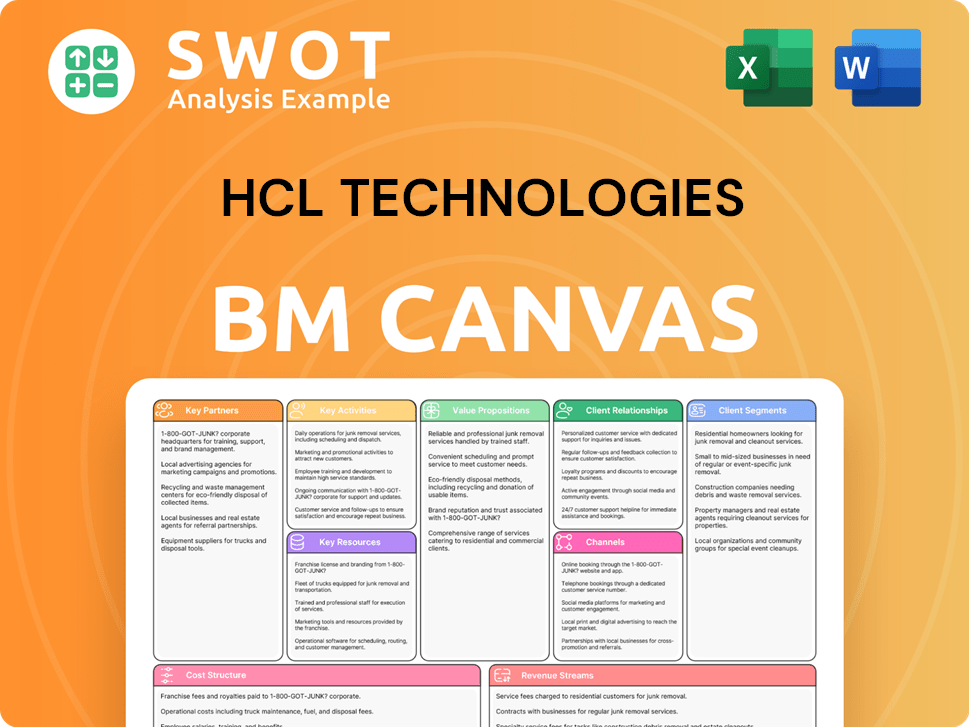
What Recent Changes Have Shaped HCL Technologies’s Ownership Landscape?
Over the past few years, the ownership of HCL Technologies has seen significant developments. A key event was in March 2025, when Shiv Nadar transferred a substantial portion of his shares in the promoter entities to his daughter, Roshni Nadar Malhotra. This strategic move is part of a family arrangement aimed at ensuring continued control and a smooth succession plan. This highlights the influence of the Shiv Nadar Family in HCL company ownership.
Furthermore, HCL Technologies has consistently demonstrated its commitment to returning value to shareholders. The company declared multiple interim dividends for the financial years 2024-2025 and 2025-2026. For instance, an interim dividend of ₹18 per equity share was declared for FY 2024-25, payable on May 6, 2025. Another interim dividend of ₹12 per equity share for FY 2024-25 was declared on October 14, 2024, payable on October 30, 2024. This reflects a focus on shareholder returns, although specific buyback announcements for 2024-2025 are not prominently featured in the latest information.
| Ownership Category | Percentage (March 2025) | Notes |
|---|---|---|
| Foreign Institutional Investors (FIIs) | 19.15% | Significant institutional stake. |
| Mutual Funds | 8.35% | A considerable portion of ownership. |
| Promoter | Significant | Maintained through family succession. |
Institutional investors continue to play a crucial role in HCL Technologies' ownership structure. As of March 2025, Foreign Institutional Investors (FIIs) hold 19.15% and Mutual Funds hold 8.35% of the shares. The company's total assets reached ₹105,544 crore (US$12 billion) and total equity reached ₹69,673 crore (US$8.2 billion) as of March 31, 2025. Additionally, HCL Technologies' revenue for FY25 is projected to increase between 3.5% and 5.0% in constant currency. For more insights into the company's origins, you can read a Brief History of HCL Technologies.
The Shiv Nadar family has ensured continued control through strategic share transfers.
FIIs and Mutual Funds hold a significant percentage of shares.
Revenue is projected to grow between 3.5% and 5.0% in constant currency for FY25.
The company continues to expand through acquisitions like the ASAP Group in 2023.
HCL Technologies Porter's Five Forces Analysis
- Covers All 5 Competitive Forces in Detail
- Structured for Consultants, Students, and Founders
- 100% Editable in Microsoft Word & Excel
- Instant Digital Download – Use Immediately
- Compatible with Mac & PC – Fully Unlocked
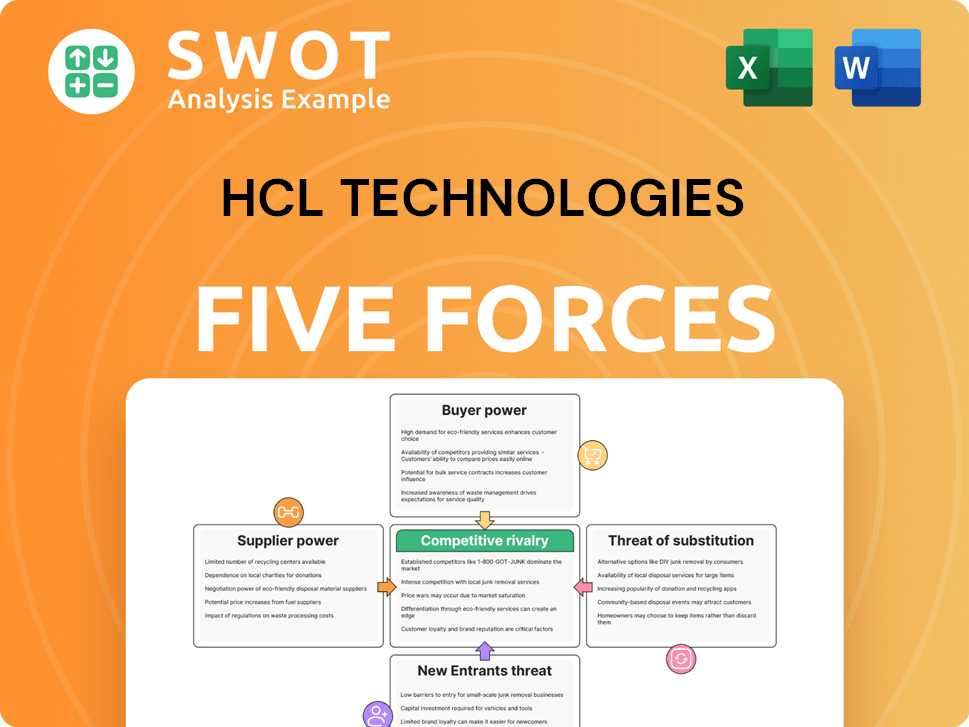
Related Blogs
- What are Mission Vision & Core Values of HCL Technologies Company?
- What is Competitive Landscape of HCL Technologies Company?
- What is Growth Strategy and Future Prospects of HCL Technologies Company?
- How Does HCL Technologies Company Work?
- What is Sales and Marketing Strategy of HCL Technologies Company?
- What is Brief History of HCL Technologies Company?
- What is Customer Demographics and Target Market of HCL Technologies Company?
Disclaimer
All information, articles, and product details provided on this website are for general informational and educational purposes only. We do not claim any ownership over, nor do we intend to infringe upon, any trademarks, copyrights, logos, brand names, or other intellectual property mentioned or depicted on this site. Such intellectual property remains the property of its respective owners, and any references here are made solely for identification or informational purposes, without implying any affiliation, endorsement, or partnership.
We make no representations or warranties, express or implied, regarding the accuracy, completeness, or suitability of any content or products presented. Nothing on this website should be construed as legal, tax, investment, financial, medical, or other professional advice. In addition, no part of this site—including articles or product references—constitutes a solicitation, recommendation, endorsement, advertisement, or offer to buy or sell any securities, franchises, or other financial instruments, particularly in jurisdictions where such activity would be unlawful.
All content is of a general nature and may not address the specific circumstances of any individual or entity. It is not a substitute for professional advice or services. Any actions you take based on the information provided here are strictly at your own risk. You accept full responsibility for any decisions or outcomes arising from your use of this website and agree to release us from any liability in connection with your use of, or reliance upon, the content or products found herein.